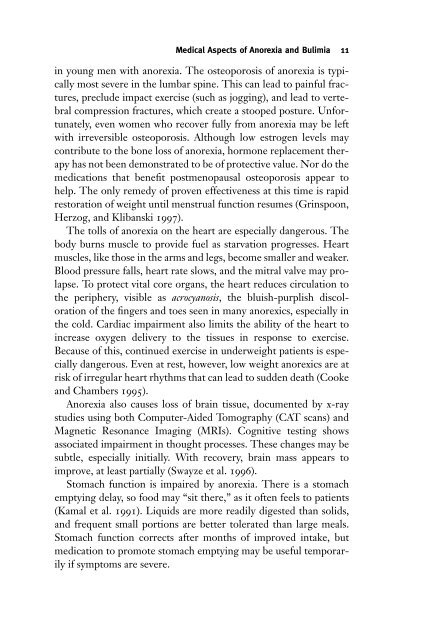Eating Disorders - fieldi
Eating Disorders - fieldi
Eating Disorders - fieldi
Create successful ePaper yourself
Turn your PDF publications into a flip-book with our unique Google optimized e-Paper software.
Medical Aspects of Anorexia and Bulimia 11<br />
in young men with anorexia. The osteoporosis of anorexia is typically<br />
most severe in the lumbar spine. This can lead to painful fractures,<br />
preclude impact exercise (such as jogging), and lead to vertebral<br />
compression fractures, which create a stooped posture. Unfortunately,<br />
even women who recover fully from anorexia may be left<br />
with irreversible osteoporosis. Although low estrogen levels may<br />
contribute to the bone loss of anorexia, hormone replacement therapy<br />
has not been demonstrated to be of protective value. Nor do the<br />
medications that benefit postmenopausal osteoporosis appear to<br />
help. The only remedy of proven effectiveness at this time is rapid<br />
restoration of weight until menstrual function resumes (Grinspoon,<br />
Herzog, and Klibanski 1997).<br />
The tolls of anorexia on the heart are especially dangerous. The<br />
body burns muscle to provide fuel as starvation progresses. Heart<br />
muscles, like those in the arms and legs, become smaller and weaker.<br />
Blood pressure falls, heart rate slows, and the mitral valve may prolapse.<br />
To protect vital core organs, the heart reduces circulation to<br />
the periphery, visible as acrocyanosis, the bluish-purplish discoloration<br />
of the fingers and toes seen in many anorexics, especially in<br />
the cold. Cardiac impairment also limits the ability of the heart to<br />
increase oxygen delivery to the tissues in response to exercise.<br />
Because of this, continued exercise in underweight patients is especially<br />
dangerous. Even at rest, however, low weight anorexics are at<br />
risk of irregular heart rhythms that can lead to sudden death (Cooke<br />
and Chambers 1995).<br />
Anorexia also causes loss of brain tissue, documented by x-ray<br />
studies using both Computer-Aided Tomography (CAT scans) and<br />
Magnetic Resonance Imaging (MRIs). Cognitive testing shows<br />
associated impairment in thought processes. These changes may be<br />
subtle, especially initially. With recovery, brain mass appears to<br />
improve, at least partially (Swayze et al. 1996).<br />
Stomach function is impaired by anorexia. There is a stomach<br />
emptying delay, so food may “sit there,” as it often feels to patients<br />
(Kamal et al. 1991). Liquids are more readily digested than solids,<br />
and frequent small portions are better tolerated than large meals.<br />
Stomach function corrects after months of improved intake, but<br />
medication to promote stomach emptying may be useful temporarily<br />
if symptoms are severe.









